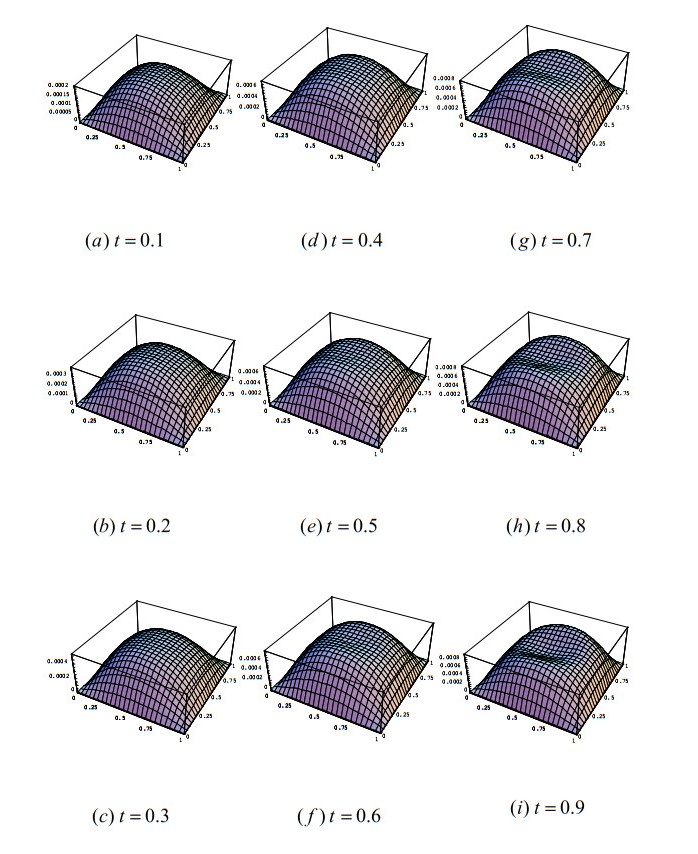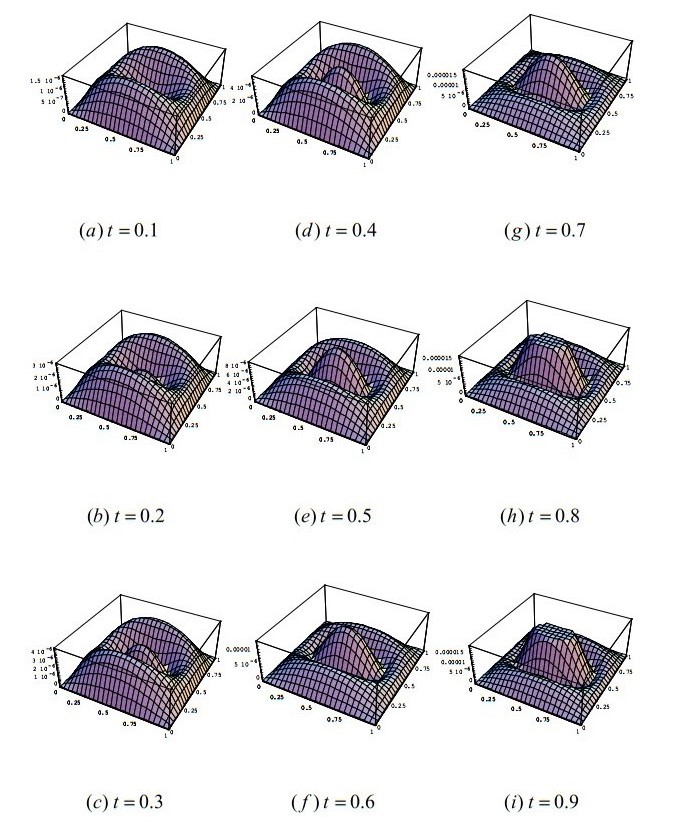1.
Introduction
The fractional diffusion equation (FDE) is widely used in engineering and science fields, such as bioengineering, electrochemistry, medicine and signal processing [1,2,3,4,5]. The references [6,7,8,9,10] are extensive and still growing rapidly on numerical approximations to solutions of FDE. Youssri and Atta [11] applied the Petrov-Galerkin Lucas polynomials procedure to time FDEs. Gupta [12] applied simplified differential transformation and homotopy perturbation to the fractional Benney-Lin equation. Attar et al. [13] used Akbar-Ganji's approach to investigate FDEs. Bota and Caruntu [14] used polynomial least squares approach to study the fractional quadratic Riccati differential equation. Moustafa, Youssri and Atta [15] applied the explicit Chebyshev-Galerkin scheme to time FDE. Djennadi, Shawagfeh and Abu Arqub [16] used a reproducing kernel (RK) approach to study the inverse source problem of FDEs. Jiang and Lin [17] studied the fractional advection-dispersion equation using the RK approach.
In this article, 2D FDEs are considered:
Here, D⊂R2 is a closed bounded field, T>0 is fixed and ∂αt [18] is defined as
where Γ is the gamma function [19,20], and r(x,y) and f(x,y,t) are given.
The objective for this article is to obtain the numerical format of the 2D FDE by the RK method. Also, superiorities for the scheme are as follows:
(ⅰ) A high-precision global approximate solution can be obtained.
(ⅱ) The numerical program is simple and the calculation speed is fast.
The RK function in the Hilbert space and its related theories have important applications in the fields of stochastic processes, machine learning, pattern recognition and neural networks [21,22,23,24,25]. The RK method can obtain the high-precision global approximate solution, and has been widely used in differential and integral equations, linear and nonlinear problems, etc. [26,27,28,29,30]. In recent years, researchers have become more and more interested in using the RK method to solve various FDEs [31,32,33,34]. These papers show that the RK method has a number of superior advantages.
The n-term approximate solution for problems (1.1)-(1.3) is given in the RK space in this article. Also, the existing approaches are improved as follows. First, inspired by references [35,36], a technique is presented to improve an existing method, which avoids the Gram-Schmidt orthogonal (GSO) procedure [17]. This method not only improves the precision, but also greatly reduces the runtime. Second, inspired by [37], a simpler RK is used than that in [38]. This improves accuracy and greatly reduces runtime [35,36]. Finally, inspired by [35], this paper extends the RK method in [17] from one-dimensional to two-dimensional, and expands the application range of the RK method to solve 2D FDEs.
For simplicity, take D=[0,1]×[0,1]⊂R2, T=1 and put u(x,y,t)=r(x,y)+w(x,y,t). Thus, problems (1.1)-(1.3) are turned into
Here, set
for w∈W(4,4,3)(G), and W(4,4,3)(G) is defined in the next section.
2.
RK space W(4,4,3)(G)
In this section, W(4,4,3)(G) is constructed according to [37] as an original book on numerical methods for RK space, which provides a simpler RK than [38].
W4[0,1]={w|w,w′,w″ and w‴ are all real valued absolutely continuous functions, w(1)=0, w(0)=0, w(4)∈L2[0,1]}. Its inner product is defined in W4[0,1] as
W3[0,1]={w|w,w′ and w″ are all real valued absolutely continuous functions, w(0)=0, w‴∈L2[0,1]}. Its inner product is defined in W3[0,1] as
The norms are defined as ‖w‖Wi=√⟨w,w⟩Wi,i=3,4. It can be shown that both W4[0,1] and W3[0,1] are RK spaces, and RKs r1 and r2 are given by (2.1) and (2.2) in [36], respectively.
Furthermore, {pk(x)}∞k=1 and {rk(t)}∞k=1 are assumed to be the orthonormal bases of W4[0,1] and W3[0,1], respectively. W(4,4,3)(G) is defined as
Its inner product and norm are respectively defined respectively as
where w1=∞∑j,k,l=1cijkpj(x)pk(y)rl(t) and w2=∞∑j,k,l=1djklpj(x)pk(y)rl(t).
With reference to [37], the following theorem can be obtained.
Lemma 2.1. W(4,4,3)(G) is an RK space whose RK is
Here, b(⋅,⋅) and h(⋅,⋅) are given by (2.1)-(2.2) in [36], respectively.
Similarly, W(2,2,2)(G) is also an RK space whose RK is
where s(⋅,⋅) is given by (2.3) in [36].
3.
Solution to problems (1.5)-(1.8)
A countable dense subset {(xj,yj,tj)}j∈N⊂G is chosen. Put ψj(x,y,t)=¯R(x,xj,y,yj,t,tj), ϕj(x,y,t)=L∗ψj(x,y,t), where L∗ is the formally adjoint operator of L.
Theorem 3.1. Let {(xj,yj,tj)}j∈N⊂G. Then,
Here, R(x,ζ,y,ς,t,τ) is shown by (2.5). The proof for this theorem is similar to that in reference [35], where a 2D parabolic inverse source problem is discussed.
Theorem 3.2. ϕj∈W(4,4,3)(G),j∈N.
Proof. From (3.1),
Then,
There are positive constants m1,m2,m3, such that
and
for (x,y,t)∈G and τ∈[0,1]. Thus,
where m4,m5 are positive constants. Hence, ∂11x4y4t3ϕj∈L2(G). Since G is closed, ∂8x3y3t2ϕj is absolutely continuous in G.
In addition, b(x,ζ),b(y,ς)∈W4[0,1], h(t,τ)∈W3[0,1] with respect to ζ,ς,τ∈[0,1] and b(1,ζ)=0, b(1,ς)=0, b(0,ζ)=0, b(0,ς)=0, h(0,τ)=0, ∂2ς2b(1,ς)=0, ∂2ς2b(0,ς)=0, ∂2ζ2b(1,ζ)=0, ∂2ζ2b(0,ζ)=0, ∂τh(0,τ)=0.
By (3.2), ϕj(x,y,0)=0, ϕj(x,1,t)=0, ϕj(x,0,t)=0, ϕj(1,y,t)=0, ϕj(0,y,t)=0, j∈N. Therefore, ϕj∈W(4,4,3)(G),j∈N by definition.
Theorem 3.3. Suppose that the solution to problems (1.1)-(1.3) is unique. Then, in W(4,4,3)(G), {ϕj}j∈N is complete.
In W(4,4,3)(G), the orthonormal system {¯ϕj}j∈N is obtained by the GSO process for {ϕj}j∈N,
Theorem 3.4. In W(4,4,3)(G), the unique solution to problems (1.5)-(1.8) is expressed as
Thus, the n-term approximate solution wn(x,y,t) is acquired by
Theorem 3.5. If w is the exact solution (ES) for Eqs (1.5)-(1.8), wn=Pnw, where Pn is an orthogonal projection of W(4,4,3) to Span{¯ϕj}j∈N, then,
The proofs of these theorems are similar to those in [35].
Thus,
Here, Cj=n∑k=jγkjk∑i=1g(xi,yi,ti)γki. The verification is listed below.
From (3.10),
Let ¯Cj=j∑i=1g(xi,yi,ti)γji. Then,
Next, Theorem 3.5 tells us that
Here, L,g and ϕj are given by (1.8) and (3.1), respectively.
In summary, the main procedures for this proposed approach are listed below.
1) Put u(x,y,t)=r(x,y)+w(x,y,t), problems (1.1)-(1.3) are turned into problems (1.5)-(1.8).
2) From Eq (3.15), Cj,j=1,2,⋯,n can be obtained.
3) Substitute Cj,j=1,2,⋯,n into Eq (3.12), numerical solution wn(x,y,t) of problems (1.5)-(1.8) can be obtained.
4) Again by u(x,y,t)=r(x,y)+w(x,y,t), the approximation un(x,y,t) for the original problems (1.1)-(1.3) can be obtained.
From the above calculation steps, it can be seen that the GSO process for {ϕj}∞j=1 in [17] may be avoided. (Here, only the proofs require the GSO step, however numerical computation does not require this step.) Therefore, compared with the method in [17], this method may improve the accuracy and greatly reduce the runtime [35,36]. This method can solve some model problems effectively and provide a high-precision global approximate solution.
4.
Convergence analysis
w(x,y,t) and wn(x,y,t) are respectively ES and the n-term approximation solution to Eqs (1.5)-(1.8). Set ‖w(x,y,t)‖C≜ Similarly to [35], the following theorem can be obtained.
Theorem 4.1. Suppose w \in {W_{\left({4, 4, 3} \right)}}(G). Then,
1) {\left\| {w - {w_n}} \right\|_{{W_{\left({4, 4, 3} \right)}}(G)}} \to 0, \quad n \to \infty . Also, {\left\| {w - {w_n}} \right\|_{{W_{\left({4, 4, 3} \right)}}(G)}} decreases monotonically with n .
2) {\left\| {\frac{{{\partial ^{l + k + j}}w}}{{\partial {x^l}\partial {y^k}\partial {t^j}}} - \frac{{{\partial ^{l + k + j}}{w_n}}}{{\partial {x^l}\partial {y^k}\partial {t^j}}}} \right\|_C} \to 0, n \to \infty; j = 0, 1;l, k = 0, 1, 2;l + k + j = 0, 1, 2.
Proof. (1) From (3.9) and (3.10),
Thus,
In addition,
Clearly, {\left\| {w - {w_n}} \right\|_{{W_{\left({4, 4, 3} \right)}}(G)}} decreases monotonically with n .
Note that
Here, {C_i}, \; i = 1, 2, \cdots, 9 are normal numbers. For all (x, y, t) \in G,
Hence,
5.
Numerical results
The effectiveness of the presented technique and the high precision of the approximate solution are verified by two examples in this section. Mathematica 5.0 software was used for all numerical calculations on a personal laptop computer.
The domain G is divided into an {m_1} \times {m_2} \times {m_3} grid with steps 1/{m_1}, 1/{m_2} and 1/{m_3} in the x, \; y and t directions, where {m_1}, {m_2}, {m_3} \in \mathbb{N}.
Example 5.1. Eqs (1.1)-(1.3) are considered based on the following conditions:
The ES is
According to the main steps (1)-(4) of the proposed method in Section 3, the absolute errors (AE) for u\left({x, y, t} \right) are given in Table 1 with grid {m_1} \times {m_2} \times {m_3} = 3 \times 3 \times 3. Root mean square errors (RMSE) for u\left({x, y, t} \right) and CPU time are shown in Table 2.
It is not difficult to see from Tables 1 and 2 that good results can be achieved when the step size is larger. Further, the CPU time is short. In addition, the accuracy increases as the step size decreases.
Moreover, errors \left| {u - {u_{27}}} \right|:t = 0.1, 0.2, \cdots, 0.9 are given in Figure 1. It is easy to see from the figure that this method can provide a high-precision global approximate solution.
Example 5.2. Questions (1.1)-(1.3) are considered based on the following conditions:
The ES is
According to the main steps (1)-(4) of the proposed method in Section 3, the AE for u\left({x, y, t} \right) are given in Table 3 with grid {m_1} \times {m_2} \times {m_3} = 3 \times 3 \times 3. Also, the RMSE for u\left({x, y, t} \right) and CPU time are shown in Table 4. It is easy to see from the two tables that good results can be achieved when the step size is larger. Further, the CPU time is short. Besides, as step size decreases, accuracy improves.
Moreover, Figure 2 shows the errors \left| {u - {u_{27}}} \right|:t = 0.1, 0.2, \cdots, 0.9. It is not difficult to see from the figure that this method can provide a high-precision global approximate solution.
6.
Conclusions and discussion
The presented method has been successfully applied to the 2D FDE in this article. Based on the RK space, the method improves existing methods [17,38], extends the RK method in [17] from one-dimensional to two-dimensional, and obtains a simpler RK than that in [38]. This improves the accuracy and greatly reduces the runtime. Numerical results demonstrate that this approch has high precision, and the error for the approximate solution decreases monotonically in the sense of {\left\| \cdot \right\|_{{W_{\left({4, 4, 3} \right)}}}} . In addition, this approch is applicable to more general FDEs, which we will discuss in an upcoming paper.
Use of AI tools declaration
The authors declare they have not used Artificial Intelligence (AI) tools in the creation of this article.
Acknowledgments
The authors thank the anonymous reviewers and the members of the management editorial board for their valuable comments. This study was funded by Innovative Training Plan Program for College Students funded by Northeast Forestry University (No. DC-2023186), Fundamental Research Funds for the Central Universities of China (No. 2572023DJ05) and National Nature Science Foundation of China (No. 11401086).
Conflicts of interest
The authors declare that they have no conflicts of interest.









 DownLoad:
DownLoad:





